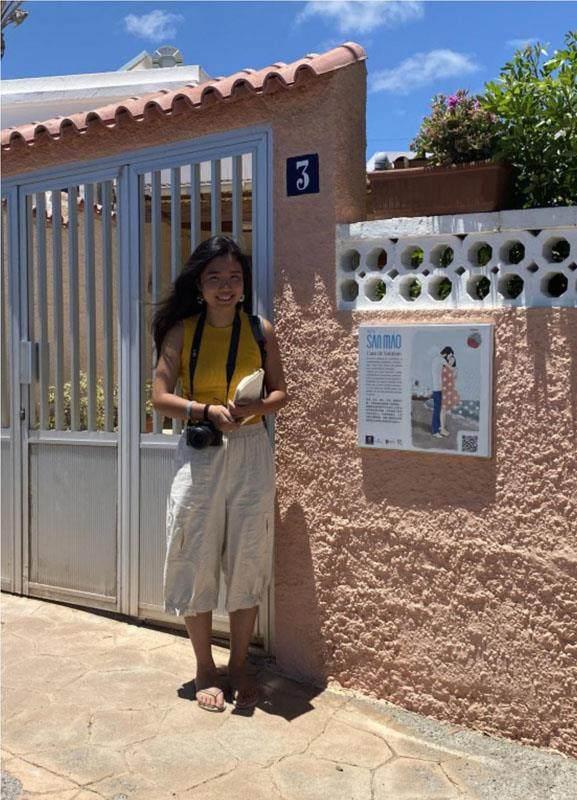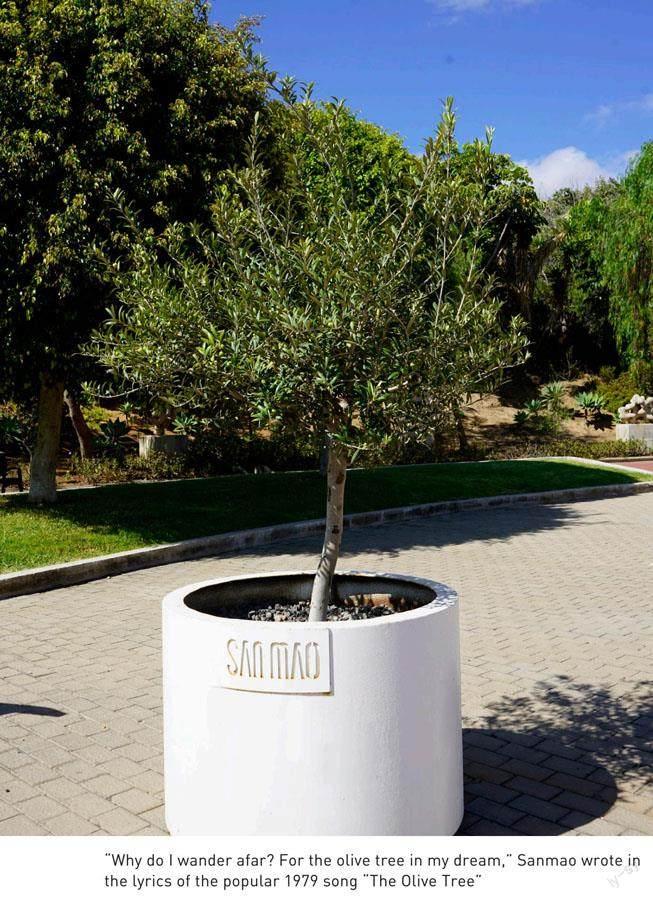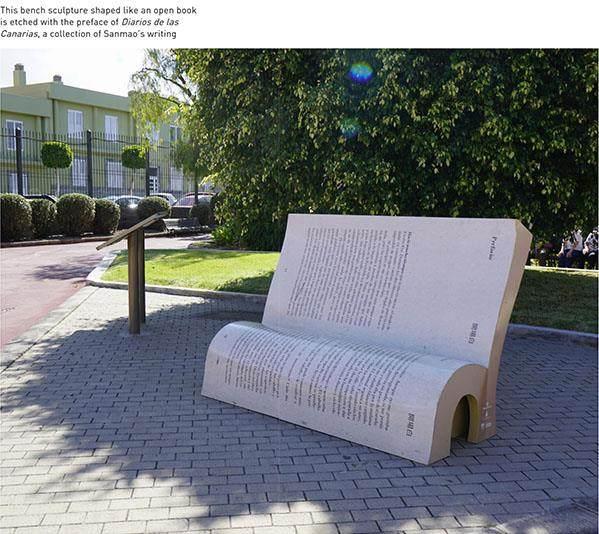在西班牙大加纳利群岛,追寻三毛的足迹



Forever Sanmao
More than 30 years after the iconic female writers passing, Sanmaos former home on Gran Canaria continues to attract tourists and fans
在西班牙大加納利群岛,追寻三毛的足迹
Text and photography by Siyi Chu (褚司怡)
The thick blanket of cloud swiftly dissipates as we cruise down south from the city of Las Palmas. “Its the trade wind.” Valentín Gonzalez, who works at the Gran Canaria Tourism Board, turns back from the front seat of the van to explain to me the peculiarities of the islands weather, promising me even gustier air when we reach our destination, Telde.
Even though Las Palmas has numerous Chinese-owned businesses, the much smaller town of Telde occupies a larger place in Chinese peoples imagination. In a quiet corner of the town lies a mural of a woman, her dark hair and white robe caressed by the wind, her gaze cast toward the ocean as blue as the wall behind her. This is the legendary writer Sanmao, who lived in the Canary Islands for several years during the late 1970s, when she was in her 30s.
Sanmao was like a gust of wind—a female writer who traveled and lived around the world and captivated a still relatively closed-off Chinese-speaking world with stories set from the West Sahara to Latin America, as well as her free-spirited lifestyle and star-crossed love story.
I learned about the Canary Islands for the first time from Sanmaos writings. The books I read under my desk instead of paying attention in class during high school in the early 2010s were not so much about the volcanoes or picturesque beaches the islands are otherwise known for. Instead, they were stories of traditional healers, Northern European retirees, a struggling nomadic Japanese artist, the Chinese diaspora community, a castanuela seller who occasionally broke out into free dance performances for her guests… For me, like many readers soaking in her tales with curiosity for the first time, the worlds and lives she described with tender tones and empathetic observations seemed like distant possibilities, but humanely real nonetheless.
So when I finally came to the island in July 2023, I was excited to trace what the writer had left behind. Thats when I came across the local tourism boards project Ruta Sanmao—a mostly walkable route that strings together sites along the trajectory of the writers life in Telde, with installations set up in her memory across the town, from a park to a library to her old house, and the mural I later stood before.
I set out on Sanmaos trail to discover the stories behind the route and the author who inspired it.
Desert echo
Hopping off at Parque Urbano de San Juan, a park on the edge of Telde, we are greeted by a small olive tree, standing alone in a white pot decorated with an understated wooden plate bearing the words “San Mao.” “This is a local species of olive,” says Valentín who replied to my interview request by offering to be my guide for a day. “Its different from the kind in Hexis hometown.”
Hexi (荷西) is the Chinese name Sanmao gave to José María Quero y Ruiz, her husband from Andalucia, a land of olive trees. José occupied much of Sanmaos writing, before and after his death at sea in 1979, just a few years into their marriage. Even nowadays, in online blogs remembering the writer, Chinese readers, many of them women, reflect on how Sanmao and José gave them a glimpse of an equal relationship based on understanding and respect.
Not far from the olive tree is a giant book sculpture that opens into the shape of a bench, inviting visitors to sit and read. Etched onto the open page is the Spanish translation of the preface toDiarios de las Canarias, a collection of Sanmaos writing on the Canary Islands. Here she quotes Dostoevsky that one must be so “lowly in love with themselves, to write about themselves without being ashamed.” Sanmao wrote that this comment “terrorized” her, but in later pages she regained her ground, vowing to “write about my sincere heart and soul in a way as free as air.”
Sanmaos intimate tone and focus on lifes trivial details resonated with 60-year-old Telde native Mari Carmen Ramos, my other guide for the day. “She writes to you like a friend,” Mari Carmen tells me, leaning against the book sculpture. This 60-year-old teacher at a local juvenile delinquency center and a poet active in the local artist community was the mastermind behind Ruta Sanmao.
Mari Carmens first encounter with Sanmao came via a small photo in a local newspaper in 2015 that showed a simple memorial plaque by the writers old house. “I was surprised to find out such a big author lived on our small island,” she tells me. “But no one around me knew about her.” Sanmao moved to Gran Canaria from the Western Sahara in the mid-70s, but her identity as a famous writer seems to have remained obscure on the island for a long time.
Back then, Mari Carmen could only find one article by Sanmao that was translated into Spanish. It was about the seven Canary Islands, probably the same one that tickled my curiosity in high school, which ends with Sanmao calling out to her readers to come to experience the islands for themselves.
“Some did come, and they wept in front of her old house,” Mari Carmen says. “We cant have them come all the way here, to have only a little plaque to see.” Collecting stories of the writers life became her passion, eventually leading to the Ruta Sanmao strewn with installations set up in Sanmaos memory.
Diaries of a dreamer
A few steps uphill from the book sculpture, a collection of large pebbles, all painted half red, contrast the green slope, which Mari Carmen envisions as a “spiritual space for meditation,” right next to the oldest cemetery in town.
When Sanmao lived on the island, she once became obsessed with painting on pebbles. For the Ruta Sanmao project, “we painted them red because red is a lucky color for Chinese people,” Mari Carmen explains. I chuckle at this trace of local interpretation. While Sanmaos writings are not without exotic intrigue to her Chinese readers, her presence on the island has drawn a similar sort of imagination from the locals toward China.
Her writing also offered an outsiders reflection on the Spanish world. Mari Carmen tells me her favorite Sanmao book is the 2016 collection ofDiarios del Sáharain which Sanmao documents her life in El Aaiún in Western Sahara at the turbulent end of Spanish colonial rule. Months after my trip to Gran Canaria, I learned from Irene Tor Carroggio, the translator of Sanmaos three collections in Spanish, thatDiarios del Sáharais the most popular Sanmao work in Spain. “Its interesting [for us Spanish readers] to read how a foreign person saw what was going on at the time, the things she paid attention to, and what surprised her about our culture,” Irene told me.
As we walk by the Basílica de San Juan Bautista, we take a break on the plaza in front, where Mari Carmen tells me a story about Sanmao that took place here. A friend of Josés had come from Madrid to comfort the grief-stricken Sanmao after her husbands death, teaching her to roller skate at this very plaza as a way to cheer her up.
“‘Im free, Im free! She yelled as she started skating.” Mari Carmen and Valentín stretch their arms out like the branches of the Indian laurels above their heads, yelling with a smile thats mixed with a frown as they retell the story to me. As the Ruta Sanmao took shape, more voices emerged to unveil small corners of the writers life on the island, making her no longer the sole narrator of her story.
In April 2016, Mari Carmen invited poets, writers, and artists from the local community to join her in celebrating Sanmao. Chinese students on the island came to the event, held in a small chapel, and sang “The Olive Trees,” written by Sanmao and popularized by Taiwanese singer Chyi Yu: “Do not ask me where Im from / My hometown is far away / Why do I wander around / Wandering afar, wandering…”
“There was this energy in the air…” Mari Carmen scans around the empty chapel as we visit. I try to hear the echo of the familiar tune inside the foreign architectural space, picturing the crowd, their eyes wet with emotions, and ponder how the “far away hometown” might have resonated differently with each of them. “We planned for 90 minutes, but it went on for 2-and-a-half hours,” Mari Carmen says.
Sanmaos “little sister”
Among the crowd that night was Nancy Zhang, a woman Sanmao befriended on the island and wrote about in her books. In 1974, when she was 13, Nancy and her family moved from Taiwan to Gran Canaria where they later took over one of the oldest Chinese restaurants in Spain that she now runs in Las Palmas.
Nancy remembers the bustle during the memorial event, “but there wasnt too much follow up, or therefore impact,” she laments to me. I didnt get to meet her on the island, but we later caught up over a video chat. In the past, local arts and literature lovers would sometimes ask her about Sanmao. “But the ages Sanmao wrote about…young people in Spain nowadays are not so in touch with them,” she says.
What is more constant, however, and not featured on the official Ruta Sanmao, is the stream of Chinese visitors who drop by Nancys restaurant just to chat with a person Sanmao (18 years Nancys senior) called “my dear Chinese little sister.” Now, Valentín calls her a “guardian of the memory.”
Though I didnt run into any Chinese visitors on my tour, many travel blogs online recount how Nancy would take out an old photo album, and tirelessly tell anyone who asked about stories of Sanmao or show them the gifts and books she had left behind.
The Chinese diaspora on the island was small in the 1970s, and Nancy and her younger sister were the only Chinese in school. Nancy was homesick in her early days on the island: “Even when you boiled it, the tap water here was too salty to drink…you couldnt even make tea with it,” she remembers. “One day I made a scene at home, asking my parents, ‘Why did you take us to such a strange place?”
In those years, just as Sanmao brought the world to Chinese-language readers, she brought a significant piece of home to Nancy. Nancy met Sanmao when she was 15 in a neighbors apartment, and began borrowing several Chinese books from the writer at a time, returning for more in a week or two. Sanmao started explaining the books to her, recommending worthy reads—and eventually, when Sanmao sold her house, she left all her books to Nancy, which she keeps today. “‘All these books—all mine? Nancy smiles dazedly, as if in a dream,” wrote Sanmao in “Gone with the Wind,” an essay about selling her house on the island a few years after José died.
Sanmao forever
“But why exactly is Sanmao so important to Chinese people nowadays?” Valentín turns back from the front seat of the van to ask me as we drive to our next destination. Sanmao tragically took her own life in 1991; her writing stopped before I was even born. Valentín had expected Chinese visitors to be 35 years old or above. “But I see mostly young women in their mid or late 20s, like you.”
Many of them stop in front of the house Sanmao and José owned in Telde: 3 Calle Lope de Vega, a spot that now shows up on Google Maps in Chinese characters as 三毛故居 (“Sanmaos old residence”). It looks nothing particular among its neighbors: a leafy tree in the yard perched over the salmon-colored outer wall. The street slopes down to the beach, revealing a big swath of the deep blue North Atlantic, juxtaposed next to the warm walls.
“Some Chinese visitors would read, some meditated. Some just stood there looking, for hours.” Valentín stands by a plaque at the door (now renovated to include an illustration of Sanmao and José in an embrace) as he speaks, and points to the curb across the street. While a few visitors knocked on the door of the owners to get closer to the writers living space, many were content just basking in the presence of Sanmaos past.
“It was like visiting a friend whom I havent seen for a long time,” Jessie Jia, writing to me over text, recalls how she burst into tears while crossing the street in front of the house. I reached out to Jessie after coming across her Instagram post with photos of her visit. “The roads I was walking on, she used to walk them too...” she adds.
In 2022, Jessie arrived at the islands airport and took a taxi straight to Sanmaos house, lecturing the driver about the writer as they went. The door was half open, but she fought the urge to disturb the owners. Content with just taking photos next to the house, she made sure to include one with the book she carried:Echo, Forever Sanmao.
A native of Harbin, Heilongjiang province, Jessie now works as an independent musician, performance artist, and diving coach in Europe. She found a kindred spirit in Sanmaos writing, especially over a shared interest in collecting trinkets from around the world. “Sanmao inspired me to sincerely, freely, and courageously be myself in this complicated world,” Jessie tells me.
Nowadays, in China, Sanmao remains not only a famous writer but a cultural phenomenon. Books about her continue to be released, including the one Jessie carried, a collection of Sanmaos images published in 2021, 30 years after Sanmaos death. Every two years in Zhoushan, Zhejiang province, where Sanmaos family has roots, an essay award named after her gives out cash prizes of up to 10,000 yuan to writers. “I knew Sanmao was big,” Mari Carmen, invited to the first edition in 2017 as a guest, recalls, “but then I realized she was immense, infinite.” Another tourist trail, Ruta Sanmao in La Palma, another of the Canary Islands where Sanmao lived for a few months, also opened in 2018.
Gone with the wind
The wind whips past the mural of Sanmao when my tour with Valentín and Mari Carmen comes to an end, right where the street in front of Sanmaos house meets the ocean at the end of the slope. When Sanmao moved away from the island one last time in the 1980s, she gave almost all her belongings away to friends, neighbors, and her house cleaner. “Just think that Im dead,” she wrote in “Gone with the Wind.”
She even took all her “16 paper boxes of letters” down to the dumpster by the beach, but a few sheets escaped in the gusts—strong as Valentín promised. She chased after them, “but they flew away like seagulls.” Perhaps along with those sheets, her story traveled on and developed a life of its own on this island, even long after she was gone.
Sanmaos mural is in a childrens playground
Many fans of Sanmao travel to the Canary Islands to catch a glimpse into the legendary authors life, even if just to take a photo outside her former house
“Why do I wander afar? For the olive tree in my dream,” Sanmao wrote in the lyrics of the popular 1979 song “The Olive Tree”
This bench sculpture shaped like an open book is etched with the preface ofDiarios de las Canarias, a collection of Sanmaos writing
Large pebbles in Telde have been painted red in commemoration of the Chinese author
Sanmao spent many years living in Madrid, Spanish Western Sahara, and the Canary Islands
Mari Carmen, one of the masterminds behind the Ruta Sanmao, with a mural featuring words from Sanmaos “The Olive Tree”
Playa del Hombre, a beach near Sanmaos former home
 汉语世界(The World of Chinese)2024年1期
汉语世界(The World of Chinese)2024年1期
- 汉语世界(The World of Chinese)的其它文章
- 编者的话
- 北京居民楼镜像史
- 信息图
- 求职路上的文理科“鄙视链”
- 在夜校,这届年轻人重新找到了生活
- 中小学老师们很忙,忙得没空教学
